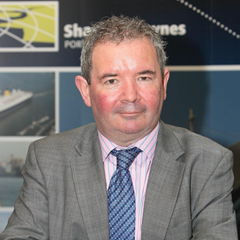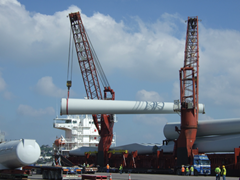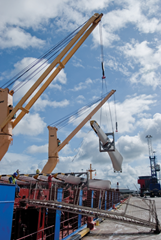Paving the way for development: Martin Morrissey
 Despite the economic downturn, the Shannon Foynes Port Company is pushing ahead with the development of the port. Commercial Manager Martin Morrissey explains the port’s plans to Owen McQuade.
Despite the economic downturn, the Shannon Foynes Port Company is pushing ahead with the development of the port. Commercial Manager Martin Morrissey explains the port’s plans to Owen McQuade.
Tight budgets for infrastructure and increasing competition from the Far East are among the biggest hurdles facing Ireland’s ports but Martin Morrissey believes there is still opportunity for expansion.
Handling just over 10 million tonnes of bulk per annum, his company deals with navigation, safe passage and technical infrastructure, as well as some onshore activities.
It services six dedicated facilities on the Shannon estuary. Foynes is the main deepwater facility catering for all key cargo, with a substantial land bank and storage facilities, and Limerick Docks is around 100km inland from the mouth of the estuary in the Mid-West region.
There are four other dedicated terminals: Shannon Airport with its aviation fuel terminals, Moneypoint and its modern local transhipment facility, Tarbert Island for heavy fuel and Aughinish catering for bauxite and alumina imports and exports.
Future development
Morrissey says plans for future developments are well underway with an “embryonic masterplan under development” for the general purpose terminal at Foynes.
The company has already sketched out how it can “add capacity” at Foynes and the first phase will be going forward for planning permission in coming weeks. “The consent process will probably take up to two years, depending on the way it goes,” explains Morrissey.
He predicts that the development will be a big advantage: “It will give us about two and a half hectares of on-quay space, which we don’t have at the moment. There is an existing jetty but there’s water on each side of it. It will fill that in basically so that gives us two and a half hectares of storage space.”
Eventually, he would like to see the current 550 metres of quayside space increased to around a kilometre.
Longer term development is also a priority. A number of sites within the estuary have been identified as suitable for customised or bespoke developments. Morrissey explains: “If you’re talking about a large- scale turbine manufacturing plant, that might need 100 hectares of manufacturing space alongside the water, for example.”
The developments don’t necessarily have to be within the offshore energy sector though, says Morrissey, they could also be “other large scale industries” that require shipments of materials in and out.
He highlights an example where the company looked at container transhipment in the past because the port at Rotterdam was working at full capacity. Shannon Foynes explored whether it would be more economic to bring the ultra-large container ships into a single point and distribute feed from there, rather than doing multiple-drop offs around Europe. However, he says that “the model didn’t quite stack up at the time”, but would be worth looking at again.
 One of the key actions in the 2005 Forfás report ‘Ahead of the Curve’ was to develop the estuary’s strategic deep water for supporting industry. “In that context it’s obviously much more medium to long term,” comments Morrissey. “We have clubbed together with the local authorities in the region of Kerry, Clare and Limerick that have joined the estuary and are engaged in creating a strategic, integrated, framework plan.”
One of the key actions in the 2005 Forfás report ‘Ahead of the Curve’ was to develop the estuary’s strategic deep water for supporting industry. “In that context it’s obviously much more medium to long term,” comments Morrissey. “We have clubbed together with the local authorities in the region of Kerry, Clare and Limerick that have joined the estuary and are engaged in creating a strategic, integrated, framework plan.”
The work of this group will set the framework for more detailed environmental systems on the specific sites, he says.
The company has been working with IDA on longer term investment but Morrissey is critical, stating that it is a “one-way process” and IDA is lacking in “clarity of vision”.
The Mid West region “hasn’t attracted a share of inward investment relative to its size and population” he says. While Cork, Galway and the greater Dublin area have attracted investment, the Mid West “seems to have fallen behind”.
Some of the older industries and the more traditional manufacturing have started to lose out to Far Eastern competition. These have shifted offshore “but there hasn’t really been any significant replacement”.
He also points to CSO unemployment statistics, which show that joblessness is a bigger problem in the Mid West than in other regions. In March, 9 per cent of people in the Mid West had signed onto the live register, which includes part-time workers, seasonal and casual workers and those entitled to jobseekers’ benefit or allowance. In comparison, 8 per cent had signed on in the Midlands.
The company has had visits from “some of the major turbine manufacturers” that have had a look at their facilities. “Unfortunately Mitsubishi and Siemens have announced that they have gone to Scotland but they are looking for significant onshore sites, 50 hectares minimum with a quayside.” This is a challenge for the industry and the core sector generally, he says.
While infrastructure and road network investments have helped, “particularly the road to Galway”, a lack of funding for road projects has been a setback. “Unfortunately it doesn’t look like the Atlantic corridor, the Cork-Limerick M20 upgrade, is going to happen in the short term due to funding. That would have been very useful because we compete with Cork, our biggest competitor.”
Connectivity to existing terminals is also problematic. There are ring roads around Limerick but drivers often have to use “sub-standard” roads such as the M69 to access these.
“There are a lot of HGV movements and we’ve done surveys on that and it’s kind of acknowledged by authorities but the message is ‘no money’,” comments Morrissey. “Even that message was a couple of years ago so it’s probably ‘definitely no money’ now. But it’s something that we will keep on the radar, when and if, conditions improve.”
Whilst there are many challenges facing Shannon Foynes Port, the company is optimistic that there will be an upswing in traffic through most terminals and that key developments will be completed in the coming years.
 Profile of Shannon Foynes Port Company
Profile of Shannon Foynes Port Company
The Shannon-based company looks after all port management on the estuary, covering 500km2 of navigable water running from Kerry and Loop Heads as far as Limerick city.
It came together after a merger in 2000 of the former Shannon Estuary and Foynes port companies, which was a rationalisation of the Irish ports sector by the Government.
In 2009, there was a cargo throughput of 7.6million tonnes, which was a 30 per cent drop from 2008.
The general purpose deepwater facility at Foynes caters for vessels up to 200m in length with draft of 10.5m. There is 30,000m2 of bulk warehousing within the port campus, as well as extensive liquid storage tanks.
Limerick city terminal has a 4.5 hectare water area and almost one kilometre of quays. It can accommodate vessels up to 152m long with a beam of 19.8m.
The Moneypoint coal transhipment facility has a 380m long berth, which services vessels up to 200,000 tonnes deepweight tonnage (dwt), with depth alongside of 25m.
The Shannon dedicated fuel jetty caters for vessels up to 6,500dwt and overall length of 130m, with depth alongside of 8.0m.
Tarbert is a T-shaped fuel jetty with a total length between outer mooring dolphins of 320m and depth alongside of 14.6m.
Aughinish is dedicated to bauxite imports and alumina exports. The 285m outer berth handles vessels up to 90,000dwt with 12.4m depth alongside, while the inner berth caters for vessels up to 40,000dwt, up to 180m long with 11.0m depth alongside.
The Kerry Deepwater Zone is a 250 hectare site and has full planning consent for deepwater berths and shipping activity.





